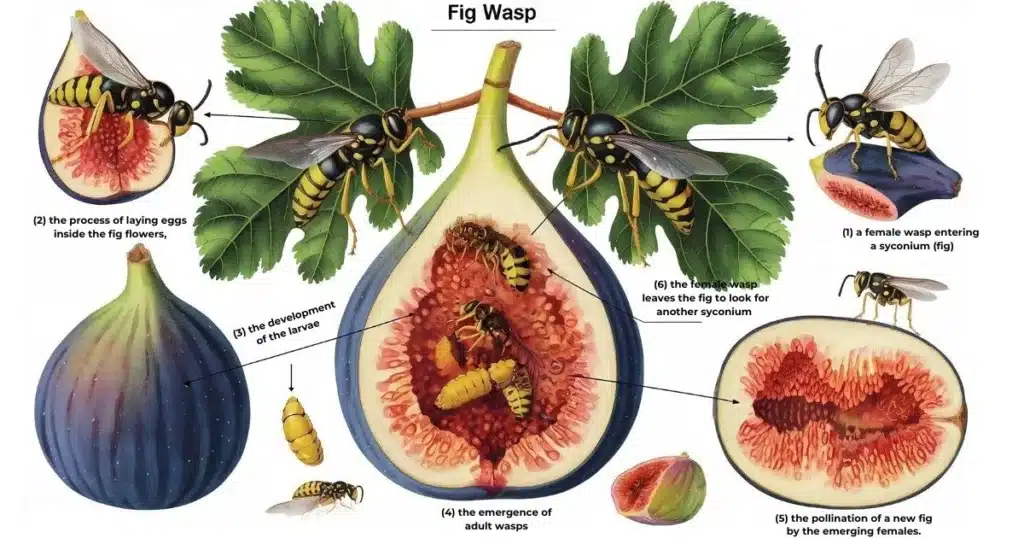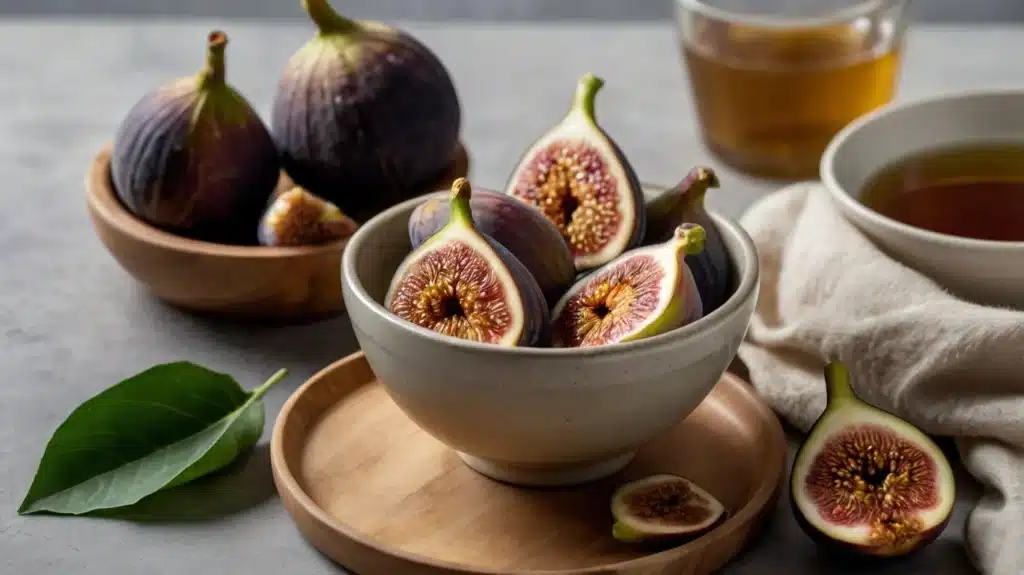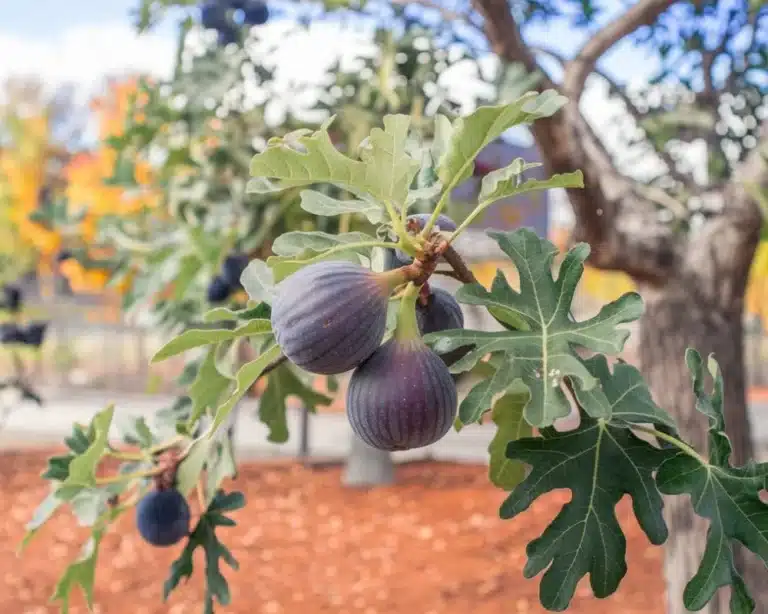Table of Contents
Understanding the Fig Tree: Physical Description and Its Ecological Partner, the Fig Wasp
The fig tree (Ficus carica) is remarkable both for its physical characteristics and its ecological significance. Native to the Mediterranean and parts of Asia, the fig tree is revered for its hardy nature, aesthetic appeal, and the delicious fruit it bears. Beyond its appearance, the fig tree hosts a fascinating relationship with the fig wasp, a tiny insect that plays a pivotal role in its life cycle.
Physical Characteristics:
Fig trees are medium-sized deciduous trees, typically growing between 10 to 30 feet tall, making them perfect for gardens of all sizes. They feature smooth, pale bark that ranges from gray to white, adding an elegant touch to their appearance. The tree’s wide, spreading crown provides ample shade, with deeply lobed, leathery leaves that are often 4 to 10 inches long. These leaves, known for their distinctive shape, offer not only beauty but also functionality, shielding the tree’s fruits from direct sunlight.
The fig, often mistaken for a true fruit, is technically a syconium—a fleshy structure that houses tiny flowers inside. As the fruit ripens, it transforms from green to shades of purple, brown, or yellow, depending on the variety. This unique structure makes figs visually appealing and biologically unique.
The Role of the Fig Wasp in the Life Cycle
The fig wasp is nature’s ingenious solution to fig pollination. Unlike other fruiting plants, fig trees depend exclusively on these tiny insects to transfer pollen. The wasp enters the syconium through a small opening, fertilizing the flowers within while laying its eggs. This relationship ensures the development of viable seeds and fruits, making the fig wasp an indispensable partner in the tree’s reproduction.

By understanding the physical traits of the fig tree and its ecological reliance on the fig wasp, gardeners and nature enthusiasts can better appreciate the intricate balance that makes this species a cornerstone of biodiversity. Incorporating a fig tree into your garden not only enhances its aesthetic appeal but also supports a vital natural process.
How to Plant a Fig Tree: Step-by-Step Guide for Beginners
Growing this fruit tree is an enriching adventure that begins with proper preparation. Whether you dream of picking fresh figs or beautifying your garden with this majestic tree, this guide will accompany you every step of the way. Fig tree cultivation is accessible to everyone, even beginner gardeners.
Essential Planting Requirements
Your chosen location should provide 6-8 hours of direct sunlight daily, with protection from strong winds. The soil must have good drainage to prevent root rot, and you’ll need enough space for the tree to reach its full potential. Before planting, carefully prepare your ground with a sturdy spade and enrich the soil with quality organic compost.
Best Time to Plant
The timing of planting significantly influences the success of your tree. Optimal periods vary according to your climate region.
| Period | Advantages | Watch Points | Soil Temperature |
| Early spring | Warmed soil, Active growth | Monitor late frosts | Minimum 50°F (Minimum 10°C) |
| Early fall | Still warm soil, Natural rain | Prepare winter protection | Above 55°F (Above 13°C) |
Container Fig Growing: The Ideal Solution for Modern Gardens
Growing this trees in containers has revolutionized urban gardening, making it possible to enjoy these delicious fruits regardless of garden space. This modern approach offers unprecedented control over growing conditions and remarkable flexibility in tree management.
Why Container Growing Works for Figs
Container cultivation particularly suits fig trees due to their adaptable root system and natural response to root restriction. Limited root space actually encourages better fruit production while keeping the tree at a manageable size. This growing method also allows gardeners to move trees for optimal sun exposure and protect them during harsh weather.
Selecting the Perfect Container
The choice of container significantly impacts your fig tree’s success:
| Feature | Minimum Requirement | Optimal Size | Reason |
| Width | 20 inches | 24-30 inches | Root spread |
| Depth | 16 inches | 18-20 inches | Root depth |
| Drainage | Multiple holes | 4-6 holes | Prevent root rot |
| Material | Weather-resistant | UV-protected | Longevity |
Creating the Optimal Growing Environment
• Professional Soil Mix Formula:
– 60% high-quality garden soil: Provides basic structure and nutrients
– 20% mature compost: Ensures sustained fertility
– 10% perlite: Creates essential air pockets
– 10% coarse sand: Improves drainage and stability
• Strategic Container Placement:
– Full sun exposure (6-8 hours minimum)
– Protection from strong winds
– Adequate spacing for air circulation
– Access to water source
– Level, stable surface
Seasonal Container Care
• Spring Management:
1. Resume regular watering as growth begins
2. Apply balanced organic fertilizer
3. Check for winter damage
4. Clean and assess container condition
• Summer Maintenance:
1. Monitor soil moisture daily
2. Provide afternoon shade in extreme heat
3. Feed with liquid fertilizer monthly
4. Support fruit-bearing branches
Watering Guide: The Key to Success
Mastering watering constitutes a fundamental element for your tree’s health:
| Growth Stage | Watering Frequency | Quantity |
| Young plant | 2-3 times weekly | 0.5-0.8 gallons |
| Established tree | Once weekly | 1.3-2.6 gallons |
| Potted fig | Every 2-3 days | 0.8-1.3 gallons |
Selecting Varieties Suited to Your Situation
Varietal choice largely determines your success. Cold regions should favor hardy varieties like ‘Brown Turkey’ or ‘Brunswick’, known for their low-temperature resistance. For container growing, opt for compact varieties like ‘Little Miss Figgy’ or ‘Petite Negra’, specially developed for restricted spaces.
| Variety | Hardiness | Production | Characteristics |
| Brown Turkey | Down to 5°F(-15°C) | Moderate | Excellent recovery |
| Brunswick | Down to 10°F (-12°C) | Abundant | Early harvest |
| Violette de Bordeaux | Down to 15°F (-9°C) | Double crop | Disease resistant |
| Little Miss Figgy | Down to 20°F (-7°C) | Moderate | Compact size, perfect for pots |
| Petite Negra | Down to 20°F (-7°C) | Abundant | Ideal for small spaces |
Regular Pruning and Maintenance
Pruning shapes your tree and stimulates fruit production. In early spring, remove dead or crossing branches to promote good air circulation. In summer, control growth to maintain a balanced shape and facilitate harvesting.
Common Problem Resolution
Yellowing leaves often signal nitrogen deficiency, while leaf spots suggest fungal issues. Irregular watering can cause fruit drop. Most difficulties resolve through regular monitoring and appropriate care.
Companion Planting for Fig Trees: Boost Growth Naturally
Companion planting is a smart gardening technique that enhances plant growth, deters pests, and improves soil health. By strategically pairing plants, gardeners can create a more resilient and productive garden. For a deeper understanding of the benefits and best practices of companion planting, check out this resource from West Virginia University Extension.
Best Companion Plants for Fig Trees
- Lavender – Repels harmful insects like aphids and ants due to its strong fragrance. It also attracts pollinators, promoting tree health.
- Marigolds – Their vibrant flowers deter nematodes and other soil-borne pests, acting as natural protectors for fig roots.
- Comfrey – A dynamic accumulator, comfrey draws nutrients from deep within the soil, making them available for neighboring plants, including fig trees.
- Basil – Repels mosquitoes and flies while enhancing the flavor of fruits grown nearby.
- Nasturtiums – These colorful flowers act as sacrificial plants, drawing aphids away from your fig tree.
- Dill and Fennel – Attract beneficial insects like ladybugs and lacewings that keep harmful pests under control.
Plants to Avoid Near Fig Trees
Avoid planting vegetables like tomatoes, potatoes, or peppers near fig trees, as these plants are susceptible to similar soil-borne diseases that may spread.
Setting Up Your Companion Garden
- Spacing and Arrangement – Allow adequate spacing between plants to avoid overcrowding and ensure proper air circulation.
- Soil Preparation – Enrich the soil with organic compost and mulch to retain moisture and suppress weeds.
- Watering Needs – Group plants with similar water requirements to simplify irrigation.
Benefits of Companion Planting
- Pest Control – Natural deterrents reduce the need for chemical pesticides.
- Improved Soil Health – Nutrient-sharing plants enhance soil fertility, reducing dependency on fertilizers.
- Pollination Boost – Attracting pollinators leads to better fruit production.
- Biodiversity – Encourages a balanced ecosystem, supporting overall plant health.
Health Benefits: Discovering the Hidden Powers of Figs
Beyond their delicious taste, figs stand out as remarkable nutritional powerhouses. Modern nutritional science continues to reveal the impressive health benefits of these ancient fruits, making them a valuable addition to any wellness-focused diet.

Digestive Health Champion
Figs contain a unique combination of soluble and insoluble fiber that promotes digestive wellness. A single serving of fresh figs (about 3-4 fruits) provides approximately 5 grams of fiber, supporting healthy digestion and regular bowel movements. The natural enzymes present in figs also aid in protein digestion, making them an excellent after-meal snack.
Skin and Anti-Aging Benefits
The high antioxidant content in figs, particularly in their dark purple skin, helps combat skin aging and promotes a healthy complexion. These compounds protect skin cells from oxidative stress, while the fruit’s natural vitamins nourish the skin from within.
Modern Ways to Enjoy Fig Benefits
• Quick Wellness Recipes:
– Morning Immune Booster Smoothie: Blend fresh figs with Greek yogurt and honey
– Pre-Workout Energy Bites: Combine dried figs with nuts and oats
– Digestive Health Tea: Steep fig leaves in hot water for a soothing drink
Wrapping Up: Unlocking the Full Potential of Your Fig Tree Garden
Cultivating fig trees can be a rewarding experience, especially when combined with proper techniques like companion planting. From understanding the fig tree’s ecological relationship with fig wasps to mastering planting, pruning, and watering, this guide has equipped you with the knowledge to create a thriving fig garden.
Whether you opt for container gardening or traditional planting, paying attention to seasonal care and problem resolution ensures long-term success. Additionally, companion planting introduces natural solutions for pest control and nutrient management, further boosting the vitality of your fig trees.
Beyond gardening benefits, figs offer numerous health advantages, making them a valuable addition to your diet. Their high fiber content supports digestion, while antioxidants promote youthful skin and overall wellness.
Now that you’re armed with expert tips and strategies, it’s time to transform your garden and enjoy the fruits of your labor. Start planting today and watch your fig trees flourish year after year!
FAQ
How much time does a fig tree need to start producing fruit?
A fig tree typically starts producing fruit 2 to 3 years after planting. However, this can vary depending on the variety, climate conditions, and care given to the tree.
When is the best time to prune a fig tree?
Prune your tree in late winter or early spring before the sap starts to rise. This stimulates growth and increases fruit production. You can also perform light pruning during summer to shape the tree.
How can I protect my fig tree from frost?
During winter, young trees or frost-sensitive varieties should be protected. Add mulch around the base of the trunk, wrap the branches with frost cloth, and, if possible, place the tree in a sheltered spot. For potted fig trees, move them into a garage or conservatory.
Why isn’t my fig tree producing fruit?
This trees may not produce fruit due to:
The tree being too young.
Insufficient sunlight (at least 6 hours a day is needed).
Over-pruning, removing fruit-bearing branches.
Soil rich in nitrogen, which encourages leaf growth over fruiting.
Can all fig varieties be eaten?
Most cultivated fig varieties are edible, but some wild figs may be bitter or unsuitable for consumption. Choose varieties like Ficus carica for their sweet flavor.
Do fig trees attract pests?
These trees can attract pests like birds, wasps, or scale insects. To minimize damage, use bird nets and inspect leaves regularly for pest activity.
How long do fig trees live?
Thes trees can live for several decades, and some may even survive over 100 years in ideal conditions. To ensure longevity, provide proper care, regular pruning, and protection from diseases.


3 thoughts on “Fig Tree Planting and Growing: A Guide to Amazing Success”